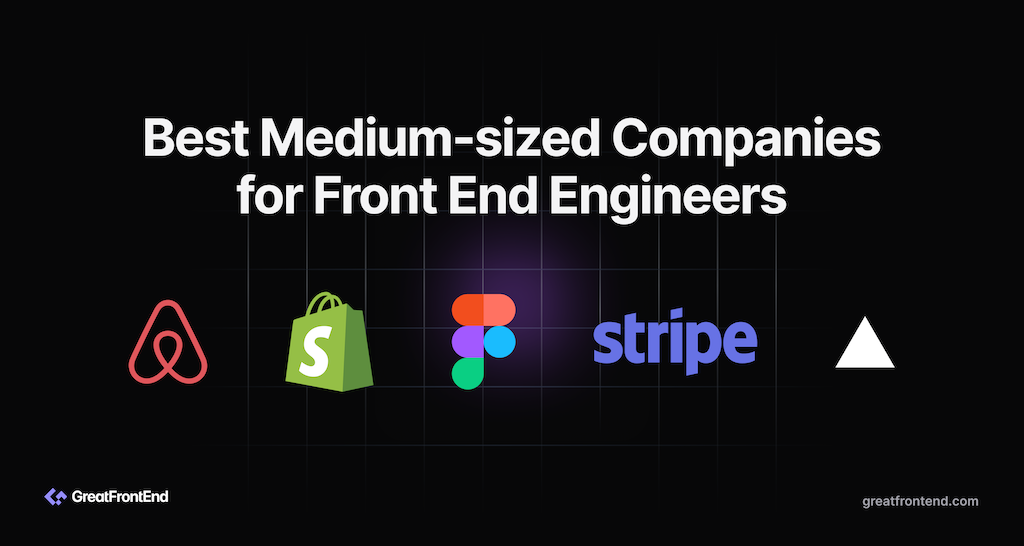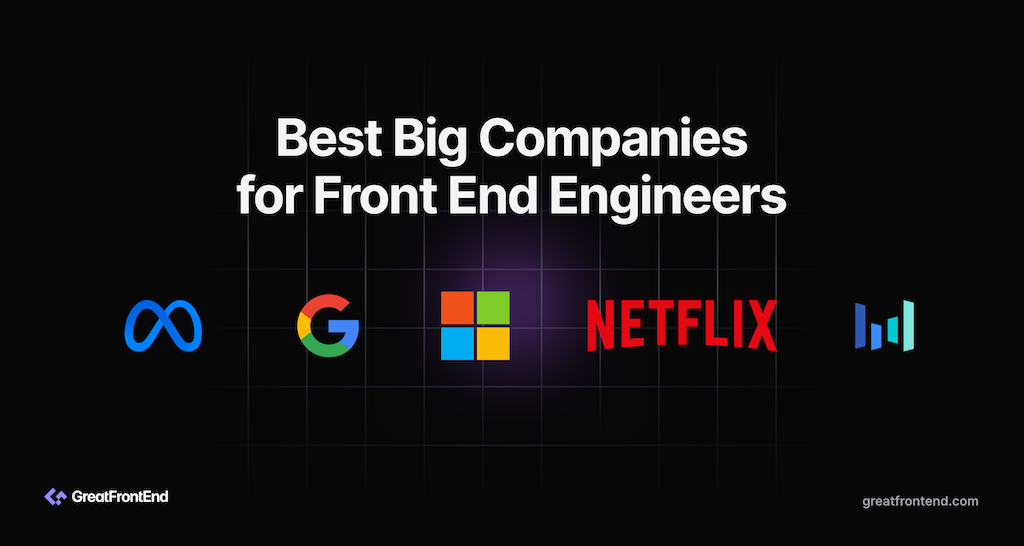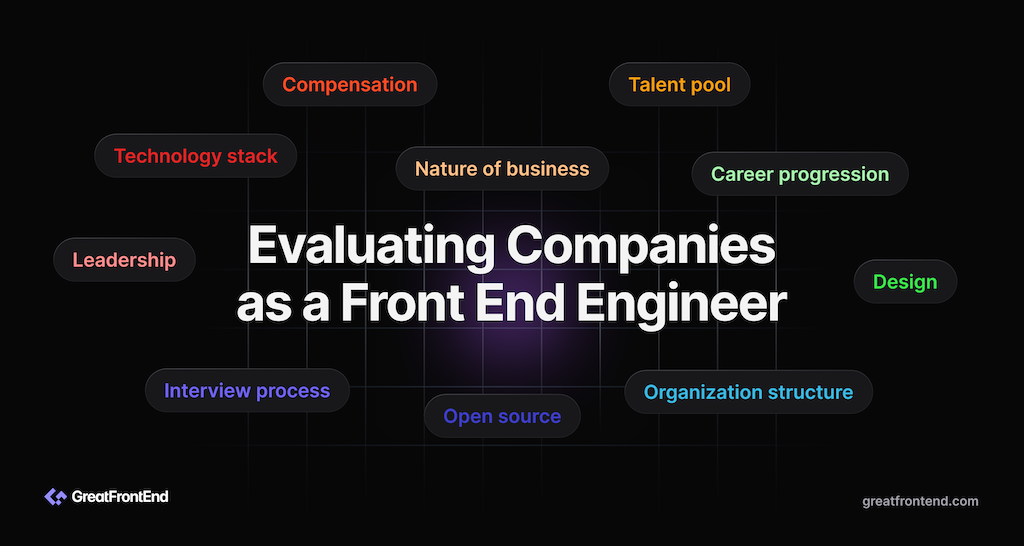Best Medium-size Companies for a Fulfilling Front End Career
Discover the best medium-sized tech companies for a great career as a Front End Engineer.
This is part 2 of our top companies series where we gathered the top tech companies for a fulfilling career as a Front End Engineer. Companies are selected based on the following criteria:
- Nature and variety of web products
- Complexity and quality of front end engineering
- Contributions to open source ecosystem
This post covers the list of the top medium-sized tech companies for front end engineers. For each company, we give a rating out of 5 on the following areas:
- Projects: Diversity, complexity and uniqueness of the products.
- Talent: Quality of talent.
- Design: Emphasis the company places on design.
- Compensation: How well compensated the employees are.
- Outlook: The company's outlook.
Airbnb
Airbnb revolutionized the travel and hospitality industry with its online marketplace for lodging and experiences. The Airbnb platform is a prime example of good design meets good engineering with its user-friendly and aesthetically pleasing interface that is used globally and supports nearly 100 languages.
Airbnb has made significant contributions to the open source community. Some of their notable open source projects include:
- JavaScript Style Guide: A very popular style guide and ESLint config for JavaScript.
- Enzyme: JavaScript testing utilities for React. It is no longer recommended since it relies on testing component implementation and the community has moved towards using React Testing Library.
- Lottie: A library for rendering animations on the web and mobile.
- visx: A collection of expressive, low-level visualization primitives for React.
- Polyglot: A tiny i18n library.
- React Dates: A datepicker library for React.
- Hypernova: A service for server-side rendering your JavaScript views.
Between 2015 to 2020, Airbnb is one of the most innovative companies in the front end space. Airbnb was one of the earliest companies to implement isomorphic/universal rendering on the web with the invention of Rendr, a library to render Backbone.js apps on the server. They also use server-driven UIs to dynamically build pages for web and mobile. Airbnb's front end team also spoke at React Conf 2019 about the process behind their design system.
Noteworthy front end engineers from Airbnb include Harrison Shoff, known for his work on Airbnb's style guide and visx. Leland Richardson, Jordan Harband, Spike Brehm, Josh Perez, were previously from Airbnb and were instrumental in shaping Airbnb's strong front end engineering culture and establishing the company as a leader in the front end ecosystem.
On the design front, Airbnb's Design department has a beautifully-designed blog and frequently shares their knowledge and resources with the designer community.
Airbnb's front end interview process mostly focused on front end coding with just one round of algorithmic coding. However, Airbnb places a high emphasis on cultural fit as the full loop consists of two rounds of behavioral interviews where most companies only have one.
As of writing, Airbnb has scaled back on their community contributions, possibly due to the global movement towards cost cutting. We no longer see as much front end innovation coming from Airbnb as compared to before. Some of Airbnb's famous libraries like Enzyme and React Dates have been moved out of the Airbnb GitHub organization and don't look maintained. Airbnb's design blog has been paused since 2022 and Airbnb's engineering and design social media accounts have been closed.
It's important to note that at its core, the Airbnb platform is a CRUD application and the challenges lie in scaling the platform for new verticals; the products themselves are not technically sophisticated client applications like a collaborative editor or design tools. However, if you are a product engineer who enjoys translating beautiful designs into reality and bringing them into the hands of people globally, Airbnb is still a cool and great place to work.
Rating: Projects (3/5), Talent (4/5), Design (5/5), Compensation (4/5), Outlook (3.5/5)
Shopify
A Canadian powerhouse, Shopify empowers businesses with its e-commerce platform, providing business owners with tools to create online stores. As these websites allow a high degree of customization by users while optimizing for performance and SEO, the Shopify platform requires complex, top quality front end engineering.
Shopify is no stranger to open source and although most of their projects are targeting the Ruby ecosystem, there are a few notable front end projects from them:
- Remix: Remix is a full stack web framework by the creators of React Routers that was acquired by Shopify and integrated into their products.
- Polaris: Shopify's design system implemented in React.
- Hydrogen: A set of opinionated components, utilities, and tools to build custom e-commerce storefronts powered by Remix and Shopify platform.
- React Native Skia: High-performance React Native Graphics using Skia.
- Draggable: A lightweight, responsive, modern drag & drop library.
In recent years, Shopify hired many well-known developers from Google like Ilya Grigorik, Jason Miller (creator of Preact), Jake Archibald, and Surma. Ryan Florence and Michael Jackson of React Router fame ended up at Shopify thanks to the Remix acquisition.
Shopify is an attractive workplace for front end engineers due to its innovative and varied product range, which offers opportunities for diverse and challenging work. The company is pushing the boundaries of e-commerce web development which demands cutting-edge development to enhance user experiences, providing developers a platform to work on impactful and widely-used applications. Shopify's embrace of the latest technologies and commitment to continuous improvement in the field also contribute to a dynamic and growth-oriented work environment. This, combined with a supportive culture and opportunities for professional development, makes Shopify a rewarding place for front end engineers.
Rating: Projects (4/5), Talent (4/5), Design (4.5/5), Compensation (3.5/5), Outlook (4/5)
Figma
Figma has become a game-changer in the design software industry, offering a cloud-based interface design tool that enables collaborative work. Figma's apps (Figma and Figjam) are possibly some of the most complex applications to exist as it is extremely challenging to build a performant design tool in the browser that scales for large design files and also offers real-time collaboration.
While Figma's direct contributions to open source are limited, its impact on the design and development community is substantial. Figma has won over the design market and has begun to focus their efforts on improving the design-to-code workflow with the introduction of Dev Mode and Storybook integration, making the product easier to use for developers.
Figma’s focus on user interface and experience design aligns well with the core competencies of front end engineering. Furthermore, the company's innovative approach and commitment to cutting-edge technology provide a dynamic environment for professional growth and learning in the field of front end development. There's a good chance that engineers who work at Figma are passionate about design and creating great user experiences; it's always great to be surrounded by like-minded people.
Rating: Projects (4/5), Talent (4.5/5), Design (5/5), Compensation (4/5), Outlook (4/5)
Stripe
Stripe provides payment processing solutions for e-commerce, characterized by their user-friendly and secure interfaces. Their front end work mainly involves creating straightforward yet secure checkouts and payment SDKs, dashboards for businesses to manage their account, prebuilt UI elements for developers who want to create their own checkout flows, and developer platform, which is a world-class example of great developer documentation.
Stripe does not have too many contributions to open source but front end engineers at Stripe have been instrumental in advancing UI/UX in financial technology. Some of their projects include Markdoc, a powerful, flexible, Markdown-based authoring framework and Sorbet, a type checker for Ruby.
Stripe is a great company for front end engineers and designers mainly due to its reputation for building elegant, user-friendly products. The company is at the forefront of financial technology, offering developers the chance to work on innovative, high-impact projects that shape the way businesses handle online transactions. Stripe's emphasis on clean, efficient code and cutting-edge technology aligns with the interests of developers who are keen on pushing the boundaries of web development. Additionally, Stripe's collaborative work culture and focus on professional growth make it a great environment for a front end engineering career.
Rating: Projects (3.5/5), Talent (5/5), Design (5/5), Compensation (4.5/5), Outlook (4/5)
Vercel
Vercel is a cloud platform focused on enhancing the development and deployment experience for front end teams. Vercel's platform is designed to make building and deploying as straightforward as possible, emphasizing ease of use, universality, and accessibility. There's seamless integration with major JavaScript frameworks, like Next.js, Remix, Nuxt, etc so that deploying sites built using these frameworks becomes a breeze. On top of hosting, Vercel also provides logs, A/B testing, storage, analytics, performance tracking, and more.
It's particularly known for creating Next.js, an open source web framework based on React. Next.js is currently the most popular meta framework for building React applications and innovating at breakneck speed especially after members of the React core team left Meta to join Vercel. Besides Next.js, Vercel is also behind projects like SWR, Turborepo, Turbopack, and SWC.
The Vercel team can be said to be the Avengers of the web development ecosystem, a congregation of top front end engineering talents. Guillermo Rauch, CEO and founder of Vercel, is a well-known figure in the development community for his work on Next.js and Socket.io. Jared Palmer, a key figure in the JavaScript community joined Vercel after they acquired his startup Turborepo. Tobias Koppers, the creator of webpack, joined Vercel to work on the evolution of webpack, Turbopack. As mentioned above, some React core team members like Sebastian Markbåge, Andrew Clark, and Dominic Gannaway, joined Vercel to continue working on React and other projects. The list goes on.
Vercel has taken Meta's place of being the industry leader in pushing the boundaries of front end innovation. Besides front end hosting, Vercel is also investing in AI with the creation of the Vercel AI SDK and v0, a tool for generative UI design.
Rating: Projects (4.5/5), Talent (5/5), Design (4.5/5), Compensation (4.5/5), Outlook (4/5)
Related articles

